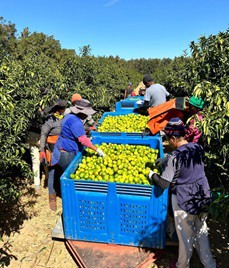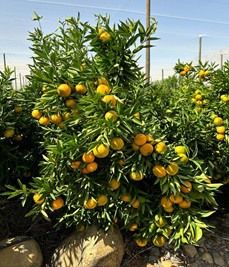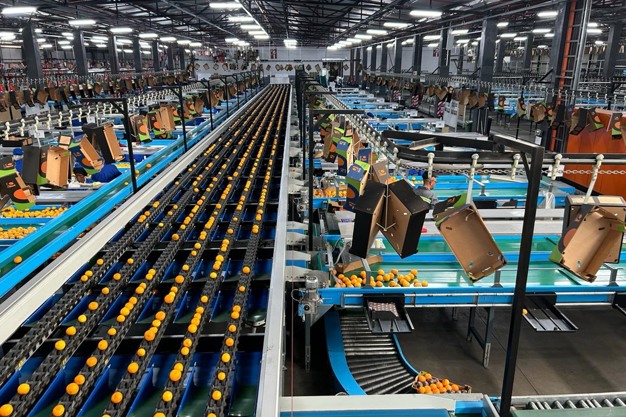 "The internals and sizing of the early clementines which we're getting from the Western Cape are looking really very good. The extra attention that we paid to thinning practices have paid off, resulting in good-sized fruit," says Jaco Burger, founder and majority shareholder of Market Demand Fruits, co-owned with citrus producers whose full crop feed into its programmes.
"The internals and sizing of the early clementines which we're getting from the Western Cape are looking really very good. The extra attention that we paid to thinning practices have paid off, resulting in good-sized fruit," says Jaco Burger, founder and majority shareholder of Market Demand Fruits, co-owned with citrus producers whose full crop feed into its programmes.
Right: ClemenLuz harvested in Gouda, Western Cape
He adds that most fruit are small this year, the Satsumas they're busy packing as well. They export between 1.4 million and 1.5 million cartons of citrus per year from South Africa (60% of that grown by shareholders, some 40% of outside production), while 200,000 cartons are locally sold. From October to February they import counterseasonal citrus from Morocco.
The effect of the weekend's gale force winds are very evident in Simondium, where their offices are based, but he's thankful that the predicted torrents of rain – 150mm to 200mm - didn't materialize.
"We're still determining the damage, but it's definitely less than expected and we can pick more than we previously thought."
European soft citrus market not switching over yet Burger notes that soft citrus demand from Europe is not the same as last year when Spain and Morocco were down by a fifth on their crops.
Burger notes that soft citrus demand from Europe is not the same as last year when Spain and Morocco were down by a fifth on their crops.
"This year their bigger crops and Egyptian fruit in the market that don't traditionally come to Europe mean that the market is definitely different from last year when it was very empty and switched over very early. That said, UK retail has started taking fruit."
Right: Hex River soft citrus (the Octubrina early clementine), grown by Dome Citrus
The Eastern Cape Satsuma harvest is in its second week, packed for export. (The Brits area (Northwest Province) started weeks back already for local retail programmes.) Octubrina is in high demand, as are all seedless varieties. He's excited by new midseason seedless varieties and the next level of genetics which will start exploring fruit with unusually pigmented rind and flesh.
The disciplined rhythm and stability provided by retail is the anchor of their business, both domestically and overseas. Burger remarks it has been interesting to see the growth of Russian retail, adding that the segmentation between retail and the wholesale market remains a necessary distinction in a market that accepts class 2 fruit.
Egypt's small oranges create space for large SA fruit
"Early indications from California are that they'll finish earlier, which then presents longer opportunity for South African product," Burger says. He is a director of the Summer Citrus programme which coordinates the logistics of Western Cape citrus to the USA. The market has kept a steady and upward course for South African citrus over the twenty years of its existence.

Octubrina is in high demand; here on the line at Stellenpak, Simondium
"Soon we'll start with navels to the USA. In Europe, there are still plenty of small oranges from Egypt, which means that there will be earlier opportunities for oranges of larger counts in Europe, although oranges don't make up a big part of our portfolio yet."
Limpopo early Valencias will start coming in about three weeks. The best navels in South Africa, in his opinion, are to be found in the Cookhouse area of the Eastern Cape and these they send to the UK, Europe and China.
It is still early days, he remarks, but they will definitely look at opportunities in Asia unlocked by Egypt's enforced absence because of the danger of passing through the Red Sea. The Chinese economy is under strain and India is on everyone's lips – a high-level delegation from the South African fruit industry have just returned from there, enthused with the possibilities. Burger adds that the country's still-developing cold chain infrastructure in India will necessitate some careful planning, patience and product with strong shelf life. For more information:
For more information:
Jaco Burger
Market Demand Fruits
Tel: +27 21 874 2028
Email: [email protected]
https://www.facebook.com/marketdemandfruits/
